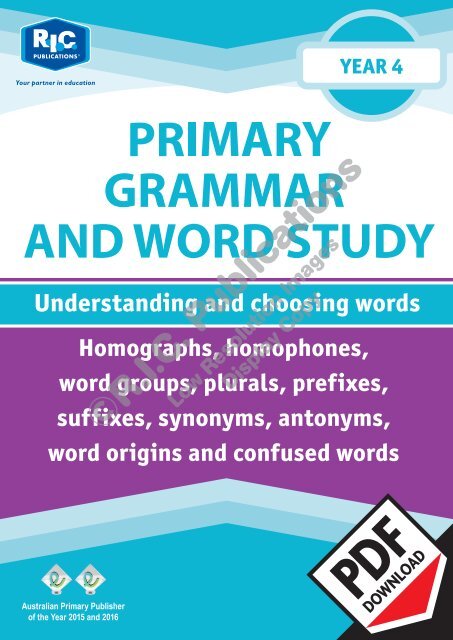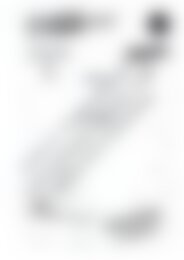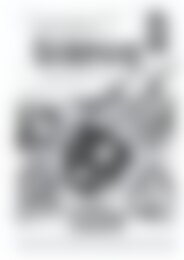RIC-20239 Primary Grammar and Word Study Year 4 – Understanding and choosing words
You also want an ePaper? Increase the reach of your titles
YUMPU automatically turns print PDFs into web optimized ePapers that Google loves.
©R.I.C. Publications<br />
Low Resolution Images<br />
Display Copy
<strong>Primary</strong> grammar <strong>and</strong> word study (Book E)<br />
Published by R.I.C. Publications ® 2008<br />
Copyright © by R.I.C. Publications ® 2008<br />
This master may only be reproduced by the<br />
original purchaser for use with their class(es). The<br />
publisher prohibits the loaning or onselling of this<br />
master for the purposes of reproduction.<br />
<strong>RIC</strong><strong>–</strong><strong>20239</strong><br />
Copyright Notice<br />
Blackline masters or copy masters are published <strong>and</strong><br />
sold with a limited copyright. This copyright allows<br />
publishers to provide teachers <strong>and</strong> schools with a<br />
wide range of learning activities without copyright<br />
being breached. This limited copyright allows the<br />
purchaser to make sufficient copies for use within<br />
their own education institution. The copyright is not<br />
transferable, nor can it be onsold. Following these<br />
instructions is not essential but will ensure that you,<br />
as the purchaser, have evidence of legal ownership<br />
to the copyright if inspection occurs.<br />
For your added protection in the case of copyright<br />
inspection, please complete the form below. Retain<br />
this form, the complete original document <strong>and</strong> the<br />
invoice or receipt as proof of purchase.<br />
Name of Purchaser:<br />
Date of Purchase:<br />
Supplier:<br />
School Order# (if applicable):<br />
Signature of Purchaser:<br />
©R.I.C. Publications<br />
Low Resolution Images<br />
Display Copy<br />
Internet websites<br />
In some cases, websites or specific URLs may be recommended. While these are checked <strong>and</strong> rechecked at the time of publication,<br />
the publisher has no control over any subsequent changes which may be made to webpages. It is strongly recommended that the class<br />
teacher checks all URLs before allowing students to access them.<br />
View all pages online<br />
PO Box 332 Greenwood Western Australia 6924<br />
Website: www.ricpublications.com.au<br />
Email: mail@ricgroup.com.au
<strong>Primary</strong> grammar <strong>and</strong><br />
word study <strong>–</strong> Book E<br />
Foreword<br />
<strong>Primary</strong> grammar <strong>and</strong> word study is a series of seven books designed<br />
to introduce students to parts of speech, ways to underst<strong>and</strong> <strong>and</strong> choose<br />
<strong>words</strong>, punctuation <strong>and</strong> figures of speech.<br />
Titles in this series:<br />
• <strong>Primary</strong> grammar <strong>and</strong> word study Book A (Ages 5<strong>–</strong> 6)<br />
• <strong>Primary</strong> grammar <strong>and</strong> word study Book B (Ages 6<strong>–</strong>7)<br />
• <strong>Primary</strong> grammar <strong>and</strong> word study Book C (Ages 7<strong>–</strong>8)<br />
• <strong>Primary</strong> grammar <strong>and</strong> word study Book D (Ages 8<strong>–</strong>9)<br />
• <strong>Primary</strong> grammar <strong>and</strong> word study Book E (Ages 9 <strong>–</strong>10)<br />
• <strong>Primary</strong> grammar <strong>and</strong> word study Book F (Ages 10<strong>–</strong>11)<br />
• <strong>Primary</strong> grammar <strong>and</strong> word study Book G (Ages 11<strong>–</strong>12)<br />
Teachers notes .............................................. iv <strong>–</strong> v<br />
Curriculum links ................................................... v<br />
Literacy character explanation ..................... vi <strong>–</strong> vii<br />
Checklists ................................................... viii <strong>–</strong> xi<br />
Parts of speech ............................................. 2<strong>–</strong>33<br />
Nouns .............................................................. 2<strong>–</strong>5<br />
Verbs .............................................................. 6<strong>–</strong>11<br />
Adjectives.................................................... 12<strong>–</strong>17<br />
Adverbs ........................................................ 18<strong>–</strong>21<br />
Pronouns ...................................................... 22<strong>–</strong>25<br />
Conjunctions ................................................ 26<strong>–</strong>27<br />
Determiners ................................................. 28<strong>–</strong>31<br />
Prepositions ................................................ 32<strong>–</strong>33<br />
Underst<strong>and</strong>ing <strong>and</strong> <strong>choosing</strong> <strong>words</strong> .......... 34<strong>–</strong>57<br />
<strong>Word</strong>s that are similar ...............................34<strong>–</strong>41<br />
Homographs ......................................... 34<strong>–</strong>35<br />
Homophones ........................................ 36<strong>–</strong>37<br />
<strong>Word</strong> groups ......................................... 38<strong>–</strong>41<br />
<strong>Word</strong>s that change .....................................42<strong>–</strong>49<br />
Plurals .................................................. 46<strong>–</strong>45<br />
Prefixes ................................................ 46<strong>–</strong>47<br />
Suffixes ................................................ 48<strong>–</strong>49<br />
Contents<br />
<strong>Word</strong>s <strong>and</strong> their meanings ........................50<strong>–</strong>53<br />
Synonyms <strong>and</strong> antonyms...................... 50<strong>–</strong>51<br />
<strong>Word</strong> origins ......................................... 52<strong>–</strong>53<br />
Confused <strong>words</strong> .........................................54<strong>–</strong>57<br />
Punctuation ................................................. 58<strong>–</strong>71<br />
Full stops, question marks <strong>and</strong><br />
exclamation marks ....................................... 58<strong>–</strong>59<br />
Capital letters ............................................... 60<strong>–</strong>61<br />
Commas ....................................................... 62<strong>–</strong>65<br />
Apostrophes ................................................. 66<strong>–</strong>69<br />
Quotation marks ........................................... 70<strong>–</strong>71<br />
©R.I.C. Publications<br />
Low Resolution Images<br />
Display Copy<br />
Figures of speech ........................................ 72<strong>–</strong>83<br />
Alliteration .................................................... 72<strong>–</strong>73<br />
Anagrams <strong>and</strong> palindromes .......................... 74<strong>–</strong>75<br />
Idioms .......................................................... 76<strong>–</strong>77<br />
Similes ......................................................... 78<strong>–</strong>79<br />
Metaphors .................................................... 80<strong>–</strong>81<br />
Personification .............................................. 82<strong>–</strong>83<br />
R.I.C. Publications ® www.ricpublications.com.au iii<br />
<strong>Primary</strong> grammar <strong>and</strong> word study
Underst<strong>and</strong>ing <strong>and</strong><br />
<strong>choosing</strong> <strong>words</strong> checklist<br />
Name of student<br />
Homographs<br />
Homophones<br />
<strong>Word</strong><br />
groups<br />
Plurals Prefixes Suffixes<br />
Synonyms/<br />
Antonyms<br />
<strong>Word</strong><br />
origins<br />
Confused<br />
<strong>words</strong><br />
©R.I.C. Publications<br />
Low Resolution Images<br />
Display Copy<br />
R.I.C. Publications ® www.ricpublications.com.au ix<br />
<strong>Primary</strong> grammar <strong>and</strong> word study
Underst<strong>and</strong>ing <strong>and</strong><br />
<strong>choosing</strong> <strong>words</strong><br />
Homographs<br />
Focus<br />
Homographs<br />
Definition<br />
• Homographs are <strong>words</strong> that are spelt the same but<br />
have different meanings.<br />
Example:<br />
duck <strong>–</strong> a waterbird with webbed feet<br />
duck <strong>–</strong> a score of zero in cricket<br />
(Note: There are more than these two meanings.)<br />
Sometimes homographs are pronounced differently.<br />
Example:<br />
lead (rhymes with red) <strong>–</strong> a heavy metal used to make<br />
pipes etc.<br />
lead (rhymes with seed) <strong>–</strong> to guide to a specific place<br />
Explanation<br />
• Recognising <strong>and</strong> using different homographs develops<br />
<strong>and</strong> enriches students’ vocabulary. They learn to<br />
underst<strong>and</strong> the meaning of <strong>words</strong> <strong>and</strong> the way they<br />
work in print.<br />
Worksheet information<br />
• As an introduction, give two quiz questions to the<br />
students to demonstrate two different meanings for the<br />
same word. For example; Question 1: What is the name<br />
for a young goat? Question 2: What is a word that means<br />
to trick or tease someone in a nice way? Ask them to<br />
guess the word <strong>and</strong> discuss the different meanings.<br />
Students may suggest other meanings for ‘kid’ such as<br />
a colloquial name for a ‘child’.<br />
• Complete Question 1 on the worksheet <strong>and</strong> discuss the<br />
students’ answers.<br />
• In Question 2, students are given crossword clues for<br />
various homographs. They complete the crossword <strong>and</strong><br />
then write each word (in any order) on the lines below.<br />
Students write another meaning alongside each word<br />
provided. Dictionaries could be used. Again, discuss<br />
students’ answers as there are more than two meanings<br />
for many <strong>words</strong>.<br />
• The word ‘wound’ in Question 3 is an example of a<br />
homograph that has different pronunciations. Discuss<br />
this with the students before they complete the activity.<br />
Discuss their answers.<br />
Ideas for further practice<br />
• Students compile a class homograph dictionary by<br />
brainstorming to list a specific number of <strong>words</strong> <strong>and</strong><br />
arrange them in alphabetical order. A word can be<br />
written at the top of a page with two or more definitions<br />
underneath.<br />
• Students identify homographs that have different<br />
pronunciations <strong>and</strong> compile a class reference chart.<br />
Suggestions include: tear (rhymes with queer)/tear<br />
(rhymes with bare); wind (rhymes with pinned)/wind<br />
(rhymes with fined); bow (rhymes with flow)/bow<br />
(rhymes with cow).<br />
Answers<br />
1. (a) Possible answer: A sentence that explains a<br />
device with prongs.<br />
(b) Possible answer: A sentence that explains to carry<br />
or support something.<br />
2. (a)<br />
1<br />
M<br />
2<br />
B O L T<br />
3<br />
G U<br />
R S<br />
4<br />
B O X E R<br />
U<br />
5<br />
C O R N<br />
A<br />
D<br />
6<br />
S E A L<br />
F<br />
(b) Possible answers for other meanings than the<br />
homophones in the crossword:<br />
bolt: to dart off suddenly<br />
boxer: a breed of dog<br />
corn: a painful lump that can form on the toes or<br />
foot<br />
seal: to close something so it can only be opened<br />
by breaking the ‘seal’<br />
©R.I.C. Publications<br />
Low Resolution Images<br />
Display Copy<br />
mouse: a device attached to a computer for<br />
controlling the curser<br />
ground: the top layer of the surface of the Earth<br />
calf: a part of the lower leg<br />
3. (a) wound (rhymes with tuned): a sore such as a cut<br />
or burn<br />
(b) wound (rhymes with found): past tense of the verb<br />
‘to wind’<br />
<strong>Primary</strong> grammar <strong>and</strong> word study 34<br />
www.ricpublications.com.au R.I.C. Publications ®
Homographs<br />
Homographs are <strong>words</strong> that have more than one meaning.<br />
1. Each word below has been written in a sentence to show one of its<br />
meanings. Write the word in another sentence to show a different<br />
meaning.<br />
(a) fork: Walk along the path for 50 metres <strong>and</strong> then take the fork to the left.<br />
(b) bear: The grizzly bear reared up on its hind legs <strong>and</strong> roared.<br />
2. (a) Complete the crossword below. The clues give one meaning for each word.<br />
Across<br />
2 A thick metal pin used to hold wood<br />
or metal together<br />
4 A person who fights using his fists<br />
5 A yellow grain crop<br />
6 A sea mammal<br />
Down<br />
1 A small rodent<br />
3 Past tense of ‘grind’<br />
5 A young cow<br />
(b) Write each word from the crossword on a line below <strong>and</strong> give a definition for a different<br />
meaning.<br />
:<br />
:<br />
:<br />
:<br />
:<br />
:<br />
:<br />
3. The word ‘wound’ can be pronounced in two ways. Give a definition for each.<br />
(a) wound (rhymes with tuned)<br />
(b) wound (rhymes with found)<br />
6<br />
R.I.C. Publications ® www.ricpublications.com.au 35<br />
<strong>Primary</strong> grammar <strong>and</strong> word study<br />
5<br />
4<br />
©R.I.C. Publications<br />
Low Resolution Images<br />
Display Copy<br />
3<br />
2<br />
1
Underst<strong>and</strong>ing <strong>and</strong><br />
<strong>choosing</strong> <strong>words</strong><br />
Homophones<br />
Focus<br />
Homophones<br />
Definition<br />
• Homophones are <strong>words</strong> that sound the same but<br />
are spelt differently <strong>and</strong> have different meanings.<br />
Example:<br />
check <strong>–</strong> to restrain, hold in restraint or control; to<br />
investigate or verify as to correctness;<br />
cheque <strong>–</strong> a written banking order, usually on a<br />
st<strong>and</strong>ard printed form directing a bank to pay a<br />
specified sum of money<br />
Explanation<br />
• The word ‘homophone’ means ‘same sound’.<br />
Homonyms (‘same name’) include both<br />
homophones <strong>and</strong> homographs (‘same writing’).<br />
• Identifying different homophones <strong>and</strong> recognising<br />
how to spell them helps students to communicate<br />
more clearly in written form. Investigating<br />
homophones also helps to develop <strong>and</strong> enrich<br />
students’ vocabulary. They learn to underst<strong>and</strong> the<br />
meaning of <strong>words</strong> <strong>and</strong> the way they work in print.<br />
• Correct spelling is essential when using<br />
homophones. There are no spelling ‘rules’ to help<br />
students remember the spelling of groups of<br />
homophones.<br />
Worksheet information<br />
• Ask the students to read the first sentence <strong>and</strong> the<br />
definition. Discuss the homophones in Question<br />
1 <strong>and</strong> work together to complete the question if<br />
necessary.<br />
• Discuss any unfamiliar vocabulary in the text such<br />
as ‘thyme’ <strong>and</strong> either read it through with the<br />
students, or allow them to read it independently.<br />
Once the text has been read, the students should<br />
have enough information to select the correct<br />
homophones.<br />
• Oral stories may be constructed first with the<br />
students adding ideas before they complete their<br />
written story.<br />
Ideas for further practice<br />
• Rewrite the complete story with the correct<br />
homophones <strong>and</strong> then use cartoon-style art to<br />
illustrate the situation.<br />
• Read <strong>and</strong> write jokes which use a ‘play on <strong>words</strong>’<br />
such as homophones or homographs.<br />
• Hold a competition to see which student can use the<br />
most homophones in a short text.<br />
Answers<br />
1. (a) piece (b) you’re/yaw/yore (c) won (d) steel<br />
(e) toe (f) bury<br />
2. The principal was getting very tired of smelling<br />
the same scent each time he went up the stairs.<br />
He decided that the person who wore it to school<br />
each day would have to know how badly it<br />
affected him <strong>and</strong> would have to stop wearing<br />
it. His poor nose was finding it hard to bear. He<br />
sneezed <strong>and</strong> blew his nose until it was red every<br />
time he passed through a cloud of it.<br />
‘Who’s there?’ he bellowed as a pair of feet<br />
approached around the corner. ‘Come out whoever<br />
it is! I won’t bite!<br />
‘Good morning Principal Parsons!’ said<br />
Superintendent Rowe. ‘I’ll be finished with my<br />
inspection today <strong>and</strong> I can say that I am very<br />
pleased with the way things are managed here.’<br />
©R.I.C. Publications<br />
Low Resolution Images<br />
Display Copy<br />
‘Atchoo!’ replied Principal Parsons.<br />
3. Teacher check<br />
<strong>Primary</strong> grammar <strong>and</strong> word study 36<br />
www.ricpublications.com.au R.I.C. Publications ®
Homophones<br />
Homophones are <strong>words</strong> that sound the same but are spelt differently<br />
<strong>and</strong> have different meanings. For example:<br />
ate/eight heard/herd wood/would plain/plane caught/court<br />
1. Write a homophone for each word.<br />
(a) peace (b) your<br />
(c) one (d) steal<br />
(e) tow (f) berry<br />
2. Circle the correct homophones from each group to complete the sentences in the text.<br />
The (principle/principal) was getting very (tired/tide/tied) of smelling the<br />
same (sent/scent/cent) each (time/thyme) he went up the (stairs/stares). He decided that the<br />
person who (war/wore) it (to/too/two) school each day (would/wood) have to (know/no) how<br />
badly it affected (him/hymn) <strong>and</strong> (would/wood) have to stop wearing it. His (pour/poor/paw/<br />
pore) nose was finding it hard to (bear/bare). He sneezed <strong>and</strong> (blew/blue) his nose until it was<br />
(read/red) every time he (passed/past) (threw/through) a cloud of it.<br />
‘(Whose/Who’s) (their/they’re/there)?’ he bellowed as a (pear/pair) of (feet/feat) approached<br />
around the corner. ‘Come out whoever it is! I won’t (bight/byte/bite)!<br />
‘Good morning (Principal/Principle) Parsons!’ said Superintendent<br />
Rowe. ‘I’ll be finished with my school inspection today <strong>and</strong> I can say<br />
that I am very pleased with the way/weigh things are<br />
managed (here/hear).’<br />
©R.I.C. Publications<br />
Low Resolution Images<br />
Display Copy<br />
‘Atchoo!’ replied (Principal/Principle) Parsons.<br />
3. Use the homophones below to write a short, silly story on a separate sheet of paper. Include as<br />
many of them as you can. Give choices for the homophones in brackets, as above, then ask a<br />
classmate to choose the correct ones.<br />
allowed aloud break brake right write bored board<br />
caught court prey pray there their hole whole<br />
knew new our hour one won threw through<br />
R.I.C. Publications ® www.ricpublications.com.au 37<br />
<strong>Primary</strong> grammar <strong>and</strong> word study
Underst<strong>and</strong>ing <strong>and</strong><br />
<strong>choosing</strong> <strong>words</strong><br />
<strong>Word</strong> groups<br />
Focus<br />
Alphabetical order<br />
Definition<br />
• Alphabetical order is a system used to arrange<br />
items so they may be easily found.<br />
Explanation<br />
• Alphabetical order is used in many areas with<br />
which students are familiar.<br />
Example:<br />
class registers, dictionaries, libraries.<br />
• Initially, <strong>words</strong> are ordered by the first letter, then the<br />
second, third <strong>and</strong> so on.<br />
Worksheet information<br />
• Prior to completing the sheet, show students<br />
examples of how alphabetical order is used in daily<br />
life; e.g. street names in road books, names in<br />
telephone directories, indexes at the back of books.<br />
• Give students short lists of related <strong>words</strong> to place in<br />
alphabetical order, explaining that if there are two<br />
or more items beginning with the same letter, the<br />
ordering is by the second, third <strong>and</strong> so on, letters.<br />
• Initially, students group <strong>words</strong> on the worksheet<br />
based on their first letter. They then place the <strong>words</strong><br />
in each group in alphabetical order. Finally, they<br />
place all <strong>words</strong> in alphabetical order.<br />
Ideas for further practice<br />
• Make a list of 20 <strong>words</strong> that are not in the dictionary<br />
used by the students in class. (They do not need<br />
to know the meaning of the word.) Provide each<br />
student with a dictionary <strong>and</strong> a sheet of paper <strong>and</strong>,<br />
for each word, ask them to record the two <strong>words</strong><br />
between which each word would be inserted in their<br />
dictionary.<br />
• Students plan a project of their choice, initially on<br />
an explosion chart <strong>and</strong> then organised into sections,<br />
determining the number of pages required for each<br />
section. Using 20 <strong>words</strong> from the explosion chart,<br />
students create an alphabetical index linked to page<br />
numbers.<br />
• At r<strong>and</strong>om, pick 20 names, addresses <strong>and</strong> telephone<br />
numbers from a directory. Give the students the<br />
list of names <strong>and</strong> addresses. Challenge the class<br />
or group to be the first to find all the telephone<br />
numbers.<br />
Answers<br />
1. (a) a <strong>–</strong> astound, aground<br />
b <strong>–</strong> brought, bought, bough<br />
c <strong>–</strong> could, caught<br />
f <strong>–</strong> found<br />
o <strong>–</strong> ought<br />
p <strong>–</strong> profound<br />
s <strong>–</strong> source, sound, souvenir, should<br />
t <strong>–</strong> thought, trough, taught, though, through<br />
w <strong>–</strong> would<br />
©R.I.C. Publications<br />
Low Resolution Images<br />
Display Copy<br />
(b) a <strong>–</strong> aground, astound<br />
b <strong>–</strong> bough, bought, brought<br />
c <strong>–</strong> caught, could<br />
s <strong>–</strong> should, sound, source, souvenir<br />
t <strong>–</strong> taught, though, thought, through, trough<br />
(c) 2. astound 3. bough<br />
4. bought 5. brought 6. caught<br />
7. could 8. found 9. ought<br />
10. profound 11. should 12. sound<br />
13. source 14. souvenir 15. taught<br />
16. though 17. thought 18. through<br />
19. trough<br />
<strong>Primary</strong> grammar <strong>and</strong> word study 38<br />
www.ricpublications.com.au R.I.C. Publications ®
Alphabetical order<br />
The alphabet can be used to organise <strong>words</strong> <strong>and</strong> make them easier to find.<br />
To begin with, <strong>words</strong> are arranged alphabetically by their first letter.<br />
If more than one word begins with this letter, the second letter is used.<br />
If this letter is the same, the third letter is used <strong>and</strong> so on.<br />
a b c d e f g h i j k l m n o p q r s t u v w x y z<br />
thought ought brought could source sound aground<br />
astound souvenir trough found would taught bought<br />
bough profound caught should though through<br />
1. Arrange the <strong>words</strong> in the box in alphabetical order.<br />
(a) Begin by placing them in groups based on their first letter.<br />
a b c<br />
f o p<br />
s t w<br />
(b) Using the next letter rule, arrange the groups with more than one word in alphabetical order.<br />
a b c s t<br />
©R.I.C. Publications<br />
Low Resolution Images<br />
Display Copy<br />
(c) Write all the <strong>words</strong> in alphabetical order. The first <strong>and</strong> last <strong>words</strong> have been done for you.<br />
1. aground 2. 3.<br />
4. 5. 6.<br />
7. 8. 9.<br />
10. 11. 12.<br />
13. 14. 15.<br />
16. 17. 18.<br />
19. 20. would<br />
R.I.C. Publications ® www.ricpublications.com.au 39<br />
<strong>Primary</strong> grammar <strong>and</strong> word study
Underst<strong>and</strong>ing <strong>and</strong><br />
<strong>choosing</strong> <strong>words</strong><br />
<strong>Word</strong> groups<br />
Focus<br />
The names of different countries, nationalities <strong>and</strong><br />
languages<br />
Explanation<br />
• Students need to develop their vocabulary to<br />
make their writing more interesting <strong>and</strong> precise.<br />
Learning about the world around them broadens<br />
their knowledge about themselves <strong>and</strong> others.<br />
Knowing the correct <strong>words</strong> to use in different<br />
writing situations will give students confidence to<br />
experiment <strong>and</strong> be more creative.<br />
• The <strong>words</strong> used for nationalities can be used as<br />
nouns or as adjectives.<br />
Example:<br />
The food at the French restaurant where we<br />
celebrated my birthday was excellent. (adjective)<br />
The French enjoy food <strong>and</strong> wine. (noun)<br />
• Many <strong>words</strong> for nationalities <strong>and</strong> languages are the<br />
same.<br />
Example:<br />
French, Spanish, Irish<br />
Worksheet information<br />
• Explain the word ‘nationality’ if the students are<br />
unsure of it.<br />
• Students may brainstorm as a class or in pairs for<br />
lists of different countries for Question 1. Explain<br />
that the name of the nationality <strong>and</strong> language are<br />
often the same.<br />
• A limerick is a poem with five lines. Lines 1, 2 <strong>and</strong> 5<br />
usually have 3 beats <strong>and</strong> rhyme, with lines 3 <strong>and</strong> 4<br />
having two beats <strong>and</strong> rhyming. Limericks are meant<br />
to be funny <strong>and</strong> the last line is usually the punchline.<br />
• Students may use three different coloured pencils<br />
to identify the country, nationality <strong>and</strong> language in<br />
Question 2.<br />
Note: For Irel<strong>and</strong>, the language <strong>and</strong> the nationality<br />
are the same word.<br />
• Students should be able to complete the table in<br />
Question 3 using their general knowledge.<br />
Ideas for further practice<br />
• Write more limericks which include countries,<br />
nationalities <strong>and</strong> the languages spoken.<br />
• Make a list of different <strong>words</strong> relating to nationalities<br />
such as abbreviations of country names (Czech,<br />
Thai), those which end in ‘-ian’ (Austrian, Indian),<br />
those which end in ‘-ish’ (Spanish, Turkish, Scottish),<br />
those which end in ‘-ese’ (Japanese, Chinese,<br />
Nepalese) <strong>and</strong> those which have different endings<br />
such as ‘-er’, ‘-i’ etc.<br />
• Learn to say some simple <strong>words</strong> in a different<br />
language or listen to another language being<br />
spoken.<br />
Answers<br />
1. Teacher check<br />
2. Dane <strong>–</strong> N, Denmark <strong>–</strong> C, Danish <strong>–</strong> L,<br />
Irel<strong>and</strong> <strong>–</strong> C, Irish <strong>–</strong> N, L<br />
3. Country Nationality Language<br />
Australia Australian English<br />
China Chinese Chinese<br />
Egypt Egyptian Arabic<br />
Great<br />
Britain<br />
©R.I.C. Publications<br />
Low Resolution Images<br />
Display Copy<br />
British<br />
English<br />
Greece Greek Greek<br />
Irel<strong>and</strong> Irish Irish/English<br />
Mexico Mexican Spanish<br />
Korea Korean Korean<br />
Pol<strong>and</strong> Polish Polish<br />
Russia Russian Russian<br />
<strong>Primary</strong> grammar <strong>and</strong> word study 40<br />
www.ricpublications.com.au R.I.C. Publications ®
Countries, nationalities <strong>and</strong><br />
languages<br />
There are many countries in the world, many people who live in them<br />
<strong>and</strong> many different languages spoken.<br />
1. In the box below, list at least ten different countries.<br />
The name of the country, the name we call a person from that country <strong>and</strong> the language the person<br />
speaks may all be different <strong>words</strong>. For example, a person from Brazil is called a Brazilian <strong>and</strong> the<br />
official language is Portuguese.<br />
2. Read the limericks, then write ‘C’ above the <strong>words</strong> which tell the country, ‘N’ for the<br />
nationality <strong>and</strong> ‘L’ for the language.<br />
There once was a Dane from Denmark<br />
Who loved taking walks in the park.<br />
Although he spoke Danish,<br />
His accent would vanish<br />
When he growled like a beast in the dark.<br />
3. Complete the table.<br />
Country Nationality Language<br />
Australia<br />
China<br />
Great Britain<br />
Mexico<br />
Russia<br />
Egyptian<br />
Polish<br />
There once was an old man from Irel<strong>and</strong><br />
Who loved to relate Irish legends<br />
His gran had told him.<br />
And though some were grim,<br />
His listeners enjoyed being frightened.<br />
©R.I.C. Publications<br />
Low Resolution Images<br />
Display Copy<br />
Arabic<br />
Greek<br />
Irish/English<br />
Spanish<br />
Korean<br />
R.I.C. Publications ® www.ricpublications.com.au 41<br />
<strong>Primary</strong> grammar <strong>and</strong> word study
Underst<strong>and</strong>ing <strong>and</strong><br />
<strong>choosing</strong> <strong>words</strong><br />
Plurals<br />
Focus<br />
Plurals: adding s or es<br />
Irregular plurals: <strong>words</strong> ending in es changing to is<br />
<strong>Word</strong>s always in the plural form.<br />
Definition<br />
• Plural is a word used to indicate more than one.<br />
Example:<br />
three apples, three brushes<br />
Explanation<br />
• ‘Singular’ means one. ‘Plural’ means more than one.<br />
• There are many ways to form the plural of a word.<br />
• To form the plural of most nouns, we just add an s.<br />
• To form the plural of <strong>words</strong> ending in <strong>–</strong>sh, <strong>–</strong>ch, <strong>–</strong>s<br />
<strong>and</strong> <strong>–</strong>x, we add es.<br />
• To form the plural of some <strong>words</strong>, the word ending<br />
changes.<br />
Example:<br />
one crisis—many crises<br />
• Some <strong>words</strong> have the same form whether the word<br />
is singular or plural.<br />
Example:<br />
one pair of glasses—many pairs of glasses<br />
• It is important that students realise that there are<br />
many exceptions to most spelling rules. They should<br />
be encouraged to identify exceptions <strong>and</strong> to share<br />
them with the class.<br />
Worksheet information<br />
• Students may be unfamiliar with some terms used<br />
on this worksheet. Ensure a dictionary is available to<br />
all students. They should be encouraged to use the<br />
dictionary to further develop these skills.<br />
• Discuss each rule <strong>and</strong> share further examples with<br />
students. Record all shared information.<br />
Ideas for further practice<br />
• Create a class list of <strong>words</strong> related to the human<br />
body or medicine.<br />
• Have a giant cut-out of a human <strong>and</strong> ask students to<br />
use the plural forms of <strong>words</strong> to label the diagram.<br />
Answers<br />
1.<br />
1. 2. 3.<br />
R V I R U S 4. E S<br />
E E I<br />
Y<br />
F I<br />
5.<br />
B O N E S<br />
6.<br />
L U N G S<br />
L<br />
E S<br />
A<br />
8.<br />
L<br />
7.<br />
X<br />
L S<br />
E E C H E S H<br />
S<br />
G E<br />
9.<br />
T O N S I L S<br />
2. diagnosis: diagnoses—the process of identifying a<br />
patient’s illness.<br />
hypnosis: hypnoses—a mental state of mind in<br />
which the mind is open to suggestion<br />
paralysis: paralyses—when all feeling or<br />
movement is lost in part or all of the body.<br />
©R.I.C. Publications<br />
Low Resolution Images<br />
Display Copy<br />
3. (a) forceps (b) measles<br />
(c) intestines<br />
<strong>Primary</strong> grammar <strong>and</strong> word study 42<br />
www.ricpublications.com.au R.I.C. Publications ®
Your body<br />
Plural is a word used to show more than one.<br />
Most nouns are made plural by adding s. Nouns ending in ch, sh, s or x<br />
can be made plural by adding es to make them easier to say.<br />
1. Use the plural form of the answers to complete the crossword puzzle.<br />
Down<br />
1. Responsive actions done without thinking.<br />
2. They carry blood back to the heart.<br />
3. The part of the skeleton which protects<br />
your heart.<br />
4. Curved hairs growing on the edge of<br />
the eyelids.<br />
7. We have two of these for walking,<br />
jumping, running.<br />
Across<br />
8.<br />
2. The cause of viral diseases.<br />
5. You have over 200 of these in your body.<br />
6. These help you to breathe.<br />
8. Bloodsucking worms once used in medicine.<br />
9. Two oval-shaped organs at the back of your throat.<br />
Nouns ending in <strong>–</strong> is can change to <strong>–</strong> es when plural.<br />
2. Use this rule to write the plural <strong>words</strong>, then write a definition of each word.<br />
word plural Definition<br />
diagnosis<br />
hypnosis<br />
paralysis<br />
1.<br />
6.<br />
9.<br />
2. 3. 4.<br />
©R.I.C. Publications<br />
Low Resolution Images<br />
Display Copy<br />
5.<br />
7.<br />
Some nouns are always written in the plural form <strong>and</strong> do not change.<br />
3. Use these plural <strong>words</strong> to complete the sentences.<br />
forceps intestines measles<br />
(a) The surgeon used<br />
(b) Most babies are immunised against<br />
during the operation.<br />
to prevent illness.<br />
(c) The<br />
are part of our digestive system.<br />
R.I.C. Publications ® www.ricpublications.com.au 43<br />
<strong>Primary</strong> grammar <strong>and</strong> word study
Underst<strong>and</strong>ing <strong>and</strong><br />
<strong>choosing</strong> <strong>words</strong><br />
Plurals<br />
Focus<br />
Plurals: <strong>words</strong> ending with y<br />
<strong>words</strong> ending with a consonant followed<br />
by o<br />
<strong>words</strong> ending with f <strong>and</strong> fe<br />
Definition<br />
• Plural is a word used to indicate more than one.<br />
Example:<br />
three apples, three brushes<br />
Explanation<br />
• ‘Singular’ means one. ‘Plural’ means more than one.<br />
• There are many ways to form the plural of a word.<br />
• To form the plural of <strong>words</strong> ending in a vowel <strong>and</strong> y,<br />
add s.<br />
Example:<br />
monkey—monkeys<br />
• To form the plural of <strong>words</strong> ending in a ‘consonant<br />
<strong>and</strong> y, change y to i <strong>and</strong> add es.<br />
Example:<br />
fly—flies<br />
• To form the plural of <strong>words</strong> ending in a consonant<br />
<strong>and</strong> o, add es.<br />
Example:<br />
tomato—tomatoes<br />
• To form the plural of some <strong>words</strong> ending in f or fe<br />
change the f or fe to v <strong>and</strong> add es.<br />
Example:<br />
calf, calves<br />
wife, wives<br />
• To form the plural of some <strong>words</strong> ending in f, add s.<br />
Example:<br />
chief—chiefs.<br />
• It is important that students realise that there are<br />
many exceptions to most spelling rules. They should<br />
be encouraged to identify exceptions <strong>and</strong> to share<br />
them with the class.<br />
Worksheet information<br />
• Discuss each rule <strong>and</strong> share similar examples with<br />
students. Record all shared information.<br />
• Discuss exceptions to the rule.<br />
Ideas for further practice<br />
• Create a nature mural <strong>and</strong> use plural terms to label<br />
the artwork.<br />
Answers<br />
1. donkeys, flies, butterflies, stingrays, joeys,<br />
canaries, dromedaries, birthdays<br />
Teacher check sentences<br />
2. (a) mosquitoes (b) volcanoes (c) potatoes<br />
(d) Mangoes (e) dingoes<br />
Note: Some dictionaries also accept mosquitos,<br />
volcanos, mangos <strong>and</strong> dingos.<br />
3. (a) knives (b) reefs (c) ourselves<br />
(d) wives (e) gulfs<br />
©R.I.C. Publications<br />
Low Resolution Images<br />
Display Copy<br />
<strong>Primary</strong> grammar <strong>and</strong> word study 44<br />
www.ricpublications.com.au R.I.C. Publications ®
Plurals<br />
Plural is a word used to show more than one.<br />
When a word ends in a vowel followed by y—just add s.<br />
When a word ends in a consonant followed by y—change y to i <strong>and</strong> add es.<br />
1. Write the plural of each word. Choose two to show each rule <strong>and</strong> write each in a short sentence.<br />
•<br />
•<br />
•<br />
•<br />
donkey<br />
butterfly<br />
joey<br />
dromedary<br />
R.I.C. Publications ® www.ricpublications.com.au 45<br />
<strong>Primary</strong> grammar <strong>and</strong> word study<br />
fly<br />
stingray<br />
canary<br />
birthday<br />
Usually when a word ends in a consonant followed by o—add es.<br />
2. Use the plural form of these <strong>words</strong> to complete the sentences.<br />
mosquito dingo potato volcano mango<br />
(a) Most people find<br />
(b) I would love to do a tour of active<br />
to visit Pompeii.<br />
(c) Mum needs six large<br />
(d)<br />
(e) Did you know that<br />
are my favourite tropical fruit.<br />
annoying, especially when they bite.<br />
around the world <strong>and</strong> I particularly want<br />
to make her yummy potato salad.<br />
don’t actually bark?<br />
Usually when a word ends in f or fe, change them to v <strong>and</strong> add es, but some <strong>words</strong> just add s.<br />
3. Circle the correct plural in each sentence.<br />
©R.I.C. Publications<br />
Low Resolution Images<br />
Display Copy<br />
(a) Please put the (knives/knifes) <strong>and</strong> forks on the table.<br />
(b) The coral (reeves/reefs) attract many divers.<br />
(c) We would really like to do it (ourselfs/ourselves)<br />
(d) The men <strong>and</strong> their (wifes/wives) went on holiday.<br />
(e) The early explorers mapped many (gulfs/gulves) along the coast.
Underst<strong>and</strong>ing <strong>and</strong><br />
<strong>choosing</strong> <strong>words</strong><br />
Prefixes<br />
Focus<br />
Prefixes: inter, sub, pre <strong>and</strong> dis.<br />
Definition<br />
• A prefix is a letter or group of letters added to the<br />
beginning of a word to alter its meaning <strong>and</strong> form a new<br />
word.<br />
Example:<br />
The Emperor dislikes those who disobey.<br />
Explanation<br />
• A prefix is a word part that has a meaning of its own,<br />
often derived from Greek or Latin. Prefixes usually do<br />
not occur as independent <strong>words</strong>. The prefix is added to<br />
the beginning of a base word to change its meaning,<br />
without changing the spelling of that word. Sometimes<br />
a hyphen is placed between the prefix <strong>and</strong> the base (or<br />
root) word, such as in the following:<br />
- when prefixes come before proper nouns<br />
Example:<br />
un-Australian, anti-American<br />
- when prefixes ending in a or i are added to a word<br />
that begins with the same letter:<br />
Example:<br />
ultra-ambitious<br />
- when the prefix is ex or self, (except for selfish <strong>and</strong><br />
selfless),<br />
Example:<br />
ex-husb<strong>and</strong>, self-centred<br />
• Ensure students learn to be aware of letter clusters that<br />
look like prefixes, but aren’t, e.g. the letters un in uncle,<br />
or in in invented.<br />
Students can practise identifying these ‘trick’ prefixes by<br />
looking at the base or root word that is left. The prefixes<br />
that cause the most difficulty are re, in <strong>and</strong> dis.<br />
• Learning the meanings of prefixes can help students<br />
decipher, spell <strong>and</strong> underst<strong>and</strong> <strong>words</strong>, especially larger<br />
<strong>words</strong>, <strong>and</strong> increase their vocabulary. Underst<strong>and</strong>ing<br />
that the spelling of neither the prefix nor the base<br />
word changes can help students to spell commonly<br />
misspelled <strong>words</strong> such as unnecessary, misspell <strong>and</strong><br />
disappointment.<br />
• Trans is a prefix meaning across, over or beyond.<br />
Example:<br />
transaction, transmission, transport, transplant<br />
• Inter means among, between or in the midst of <strong>and</strong><br />
often indicates a connection between things.<br />
Example:<br />
interschool, interstate, interactive<br />
• Sub has a number of meanings;<br />
Example:<br />
under, beneath, below (submarine, submerge),<br />
(subnormal) <strong>and</strong> nearly (subcentral)<br />
• Pre can mean earlier than, before (prehistoric)<br />
or in front of (premolar).<br />
• Dis has a number of meanings; when attached to<br />
verbs it usually means to reverse or do the opposite<br />
(disagree, disbelieve) or to remove (disrobe, disarm);<br />
when added to nouns it commonly means opposite<br />
(disrespect, distaste), <strong>and</strong> when added to adjectives or<br />
past participles means not (dishonest, disobedient).<br />
Worksheet information<br />
• Discuss the definition of prefixes with the students.<br />
Describe how each prefix has a meaning of its own, <strong>and</strong><br />
when added to another word changes the meaning of<br />
that word. Write some examples of <strong>words</strong> with prefixes,<br />
<strong>and</strong> allow the students to draw a line dividing the<br />
prefixes from the base <strong>words</strong>. Discuss how sometimes<br />
a word might look like it has a prefix; e.g. predator.<br />
Remind students to check if the following letters form a<br />
base word or not, to determine if it is a prefix.<br />
• Read the story with the students. Some may not<br />
underst<strong>and</strong> all the <strong>words</strong>; what is important is that<br />
they hear the prefixes in context <strong>and</strong> underst<strong>and</strong> the<br />
general story. Students then complete the worksheet as<br />
directed.<br />
• It is important that there is a conclusion to this activity.<br />
Students need to conference in small groups, or discuss<br />
their findings as a class. Each small group (or the whole<br />
class) should compile a set of meanings for each prefix<br />
that the teacher should ensure is correct.<br />
©R.I.C. Publications<br />
Low Resolution Images<br />
Display Copy<br />
Ideas for further practice<br />
• Students could compare the meanings of <strong>words</strong> with the<br />
prefix in <strong>and</strong> the prefix inter.<br />
• Search for more <strong>words</strong> with the prefix inter- using<br />
books, magazines <strong>and</strong> newspapers.<br />
Answers<br />
1. Teacher check<br />
<strong>Primary</strong> grammar <strong>and</strong> word study 46<br />
www.ricpublications.com.au R.I.C. Publications ®
Prefixes<br />
Prefixes are groups of letters in front of <strong>words</strong> that change the meaning of the<br />
word; for example: unhappy.<br />
1. (a) Read the story <strong>and</strong> take note of the prefixes in bold.<br />
Tariq disliked the feeling he got each time he went down the lift into the secret<br />
submarine lab. He felt alone <strong>and</strong> disconnected from the real world down in this<br />
suboceanic building. Still, they needed someone to preview the data from the specially<br />
trained spy-dolphins before the international secrets were sent to powerful intercity<br />
officials. Tariq had wanted to work with dolphins since he was in preschool. He exited<br />
the lift, punched his code into the alarm, then froze as the door to his lab slid open. The<br />
lab was in total disarray; papers were on the floor, computers were smashed. Who had<br />
broken into his lab, <strong>and</strong> why? What should he do now?<br />
(b) Choose three of the four different prefixes from the story <strong>and</strong><br />
write them in the table below.<br />
(c) Write two <strong>words</strong> from the story with that prefix.<br />
(d) Write a definition to explain the meaning of each word.<br />
(e) Work out what each prefix means.<br />
(b) Prefix (c) <strong>Word</strong>s (d) Definition of <strong>words</strong> (e) Meaning of prefix<br />
•<br />
•<br />
•<br />
•<br />
•<br />
©R.I.C. Publications<br />
Low Resolution Images<br />
Display Copy<br />
•<br />
•<br />
•<br />
•<br />
•<br />
•<br />
•<br />
R.I.C. Publications ® www.ricpublications.com.au 47<br />
<strong>Primary</strong> grammar <strong>and</strong> word study
Focus<br />
Suffixes ed, er <strong>and</strong> ing.<br />
Definition<br />
Underst<strong>and</strong>ing <strong>and</strong><br />
<strong>choosing</strong> <strong>words</strong><br />
• A suffix is a letter or group of letters added to the end<br />
of a base word to change its meaning <strong>and</strong> form a new<br />
word.<br />
Explanation<br />
• Generally, when a suffix is added to a base word, the<br />
spelling of both stays the same. There are a number of<br />
rules, however, when adding a suffix beginning with a<br />
vowel, such as ing, ed <strong>and</strong> er.<br />
• The final consonant must be doubled before adding<br />
the suffix to <strong>words</strong> of one syllable with a short vowel<br />
followed by a consonant.<br />
Example:<br />
hop <strong>–</strong> hopped, run <strong>–</strong> running<br />
This rule also applies to <strong>words</strong> of two or more<br />
syllables, provided the accent falls on the last<br />
syllable.<br />
Example:<br />
forget <strong>–</strong> forgotten<br />
Exceptions are bus, gas <strong>and</strong> <strong>words</strong> that end in w.<br />
• Consonants are not doubled after a long or double<br />
vowel,<br />
Example:<br />
clean <strong>–</strong> cleaning, sleep <strong>–</strong> soaking<br />
• In <strong>words</strong> ending in a silent e, the e is usually dropped.<br />
Example:<br />
hope <strong>–</strong> hoping, please <strong>–</strong> pleasing, tune <strong>–</strong> tuning<br />
• <strong>Word</strong>s ending in ac or ic, add a k before the suffix,<br />
Example:<br />
panic <strong>–</strong> panicked, mimic <strong>–</strong> mimicking,<br />
picnic <strong>–</strong> picnicker<br />
• <strong>Word</strong>s that ends in y, change the y to an i before<br />
adding the suffix (e.g. easy<strong>–</strong>easiest), unless a vowel<br />
comes before it (e.g. play<strong>–</strong>played) or the suffix is ing<br />
(e.g. carrying, hurrying).<br />
• There are some exceptions to these rules.<br />
• Knowing the meanings of common suffixes may assist<br />
students to work out the meaning of unfamiliar <strong>words</strong>. A<br />
sound knowledge of suffixes will also help students spell<br />
correctly <strong>and</strong> develop their vocabulary. An underst<strong>and</strong>ing<br />
of suffixes can also help students identify which part of<br />
speech (noun, verb, adjective, adverb) the word belongs to.<br />
Worksheet information<br />
• By completing this worksheet, students should discover<br />
for themselves at least one of the rules regarding adding<br />
these suffixes to certain base <strong>words</strong>.<br />
Suffixes<br />
• Read the introduction <strong>and</strong> check for student<br />
underst<strong>and</strong>ing. Allow students to look at the text in their<br />
own time <strong>and</strong> underline <strong>words</strong> which have a base that<br />
changes spelling when the suffix is added. Provide<br />
dictionaries for student reference if necessary. Students<br />
then complete the <strong>words</strong>earch, locating new <strong>words</strong><br />
created from the base <strong>words</strong> by the addition of suffixes.<br />
• In Question 3, students write one rule they observed.<br />
• As a follow-up activity, ask students to share some<br />
of the rules they have discovered. Write the correct<br />
rules on a chart to put up in the classroom for student<br />
reference.<br />
• Teachers could choose to follow this activity with a more<br />
in-depth study of the rules pertaining to adding certain<br />
suffixes to certain <strong>words</strong> as listed above.<br />
• It is important that students realise there are exceptions<br />
to most of these rules. They should be encouraged to<br />
identify exceptions <strong>and</strong> to share them with the class.<br />
Ideas for further practise<br />
• <strong>and</strong> are online<br />
interactive activities where students can practise adding<br />
these suffixes.<br />
• Send students on a ‘suffix hunt’ around the classroom<br />
to try to find <strong>words</strong> that have changed spelling once a<br />
suffix has been added.<br />
• At http://teacher.scholastic.com/activities/adventure/<br />
grammar4.htm# students can practise adding ed <strong>and</strong><br />
ing to <strong>words</strong> in the fishing game.<br />
Answers<br />
1. winner (double n), announcer (silent e is dropped),<br />
winner (double n), cried (y changed to i), excited<br />
(silent e is dropped), confused (silent e is dropped),<br />
happier (y changed to i), picnicking (k added before<br />
ing), tail-waggers (double g).<br />
©R.I.C. Publications<br />
Low Resolution Images<br />
Display Copy<br />
2. cry-cried, marry-married, win-winning,<br />
move-moving, play-played, try-tried, wag-wagging,<br />
hurry-hurrying, dig-digging<br />
q e e m o v i n g w<br />
l p l a y e d i m a<br />
n p t r i e d n i g<br />
h u r r y i n g o g<br />
u t w i n n i n g i<br />
c r i e d t r e s n<br />
n a q d i g g i n g<br />
3. Teacher check<br />
<strong>Primary</strong> grammar <strong>and</strong> word study 48<br />
www.ricpublications.com.au R.I.C. Publications ®
Suffixes<br />
Suffixes are letters added to the end of base <strong>words</strong>. Sometimes suffixes,<br />
like ed, er <strong>and</strong> ing change the spelling of the base word they join.<br />
1. (a) Read the story below <strong>and</strong> notice the spelling of the <strong>words</strong> with suffixes.<br />
Okay, it’s time folks. Time to choose the winner of our concert ticket contest’, the<br />
radio announcer crooned. ‘Hello caller on line three!’<br />
‘ME? Am I the winner? Oh WOW!! I’ve been trying to get through for hours!’ a female<br />
voice cried.<br />
‘Well, hang on there caller. Could you start by identifying yourself?’<br />
‘Oh, oo, oh, ah, I’m so thrilled!’, squawked the excited voice.<br />
‘Well, Sothrild, that’s an interesting name’, said the confused announcer.<br />
‘Oh, no, my name is Emily, <strong>and</strong> I’ve never been happier!’ she squealed.<br />
‘Okay, Emily, you are now the lucky owner of two tickets to see The Picnicking Tailwaggers<br />
live in concert next week.’<br />
‘Oh! Yes! Awesome! Thank you! Woohooooo!’<br />
(b) Underline the base <strong>words</strong> that changed when a suffix was added.<br />
2. Ed, er or ing has been added to the following base <strong>words</strong> in the <strong>words</strong>earch. Find the new<br />
<strong>words</strong> <strong>and</strong> write them next to the base word.<br />
Base <strong>words</strong><br />
cry<br />
marry<br />
win<br />
move<br />
play<br />
try<br />
wag<br />
hurry<br />
dig<br />
q e e m o v i n g w<br />
©R.I.C. Publications<br />
Low Resolution Images<br />
Display Copy<br />
l p l a y e d i m a<br />
n p t r i e d n i g<br />
h u r r y i n g o g<br />
u t w i n n i n g i<br />
c r i e d t r e s n<br />
n a q d i g g i n g<br />
3. Write one thing you have noticed about adding some of these suffixes.<br />
R.I.C. Publications ® www.ricpublications.com.au 49<br />
<strong>Primary</strong> grammar <strong>and</strong> word study
Underst<strong>and</strong>ing <strong>and</strong><br />
<strong>choosing</strong> <strong>words</strong><br />
Synonyms <strong>and</strong> antonyms<br />
Focus<br />
Synonyms <strong>and</strong> antonyms<br />
Definitions<br />
• Synonyms are <strong>words</strong> that have the same or similar<br />
meaning.<br />
Example:<br />
child <strong>–</strong> infant<br />
• Antonyms are <strong>words</strong> that are opposite in meaning.<br />
Example:<br />
sweet <strong>–</strong> sour <strong>–</strong> unpleasant<br />
Explanation<br />
• Identifying synonyms <strong>and</strong> antonyms develops <strong>and</strong><br />
enriches students’ vocabulary <strong>and</strong> enhances their<br />
written <strong>and</strong> verbal communication.<br />
• Identifying <strong>and</strong> using more ‘interesting’ synonyms,<br />
such as other <strong>words</strong> for ‘nice’ or ‘said’ can give<br />
more meaning to a sentence or more interest to a<br />
description.<br />
• Antonyms <strong>and</strong> synonyms are often used as clues for<br />
crossword puzzles.<br />
• As <strong>words</strong> can have many meanings, the context<br />
in which the word is used must be taken into<br />
consideration.<br />
Worksheet information<br />
• Identical twins occur when one fertilised egg (ovum)<br />
splits <strong>and</strong> forms two babies with exactly the same<br />
genetic makeup. Fraternal twins occur when two<br />
separate eggs (ova) are fertilised by two different<br />
sperm <strong>and</strong> form two children with different genetic<br />
information.<br />
• Differentiate between synonyms <strong>and</strong> antonyms<br />
as described on the worksheet <strong>and</strong> discuss some<br />
examples.<br />
• Students should read the text <strong>and</strong> the clues to<br />
complete the crossword. Whether the answer is a<br />
synonym or antonym of the word given is indicated<br />
in brackets.<br />
Ideas for further practice<br />
• Complete other crossword puzzles <strong>and</strong> identify the<br />
synonyms used in clues.<br />
• Change the meaning of a sentence by substituting<br />
antonyms.<br />
• As a class, list <strong>and</strong> record synonyms of <strong>words</strong><br />
‘over-used’ in writing such as ‘said’ <strong>and</strong> ‘nice’.<br />
Answers<br />
1. (a) powerful (b) rescue<br />
(c) durable (d) correct<br />
2. Answers will vary but may include:<br />
(a) cheap (b) divide<br />
(c) friend (d) deep<br />
3.<br />
1.<br />
I<br />
3.<br />
4.<br />
B<br />
O<br />
Y<br />
S<br />
F<br />
6.<br />
T<br />
F<br />
E<br />
R<br />
©R.I.C. Publications<br />
Low Resolution Images<br />
Display Copy<br />
9.<br />
A<br />
11.<br />
C<br />
7.<br />
S<br />
M<br />
A<br />
L<br />
L<br />
H<br />
W<br />
A<br />
A<br />
N<br />
8.<br />
D<br />
E<br />
N<br />
T<br />
I<br />
C<br />
A<br />
L<br />
E<br />
A<br />
S<br />
Y<br />
G<br />
T<br />
N<br />
10.<br />
S<br />
A<br />
M<br />
E<br />
2.<br />
T<br />
R<br />
O<br />
U<br />
B<br />
L<br />
E<br />
J<br />
R<br />
O<br />
N<br />
Y<br />
5.<br />
T<br />
E<br />
A<br />
C<br />
H<br />
E<br />
R<br />
L<br />
D<br />
<strong>Primary</strong> grammar <strong>and</strong> word study 50<br />
www.ricpublications.com.au R.I.C. Publications ®
Synonyms <strong>and</strong> antonyms<br />
Antonyms are <strong>words</strong> with the opposite meaning.<br />
Synonyms are <strong>words</strong> with the same or similar meaning.<br />
1. Write synonyms for ...<br />
(a) strong (b) save<br />
(c) tough (d) right<br />
2. Write antonyms for ...<br />
(a) expensive<br />
(c) enemy<br />
(b) multiply<br />
(d) shallow<br />
3. Find <strong>words</strong> in the text to answer the clues in the crossword puzzle.<br />
Ron <strong>and</strong> Todd were identical twins but Sarah <strong>and</strong> Sasha were fraternal twins. They were all in the<br />
same class. Their teacher, Mr Scott, found it very easy to tell Sarah <strong>and</strong> Sasha apart but he was<br />
always confusing Ron <strong>and</strong> Todd.<br />
1.<br />
Of course, the boys really enjoyed<br />
confusing Mr Scott. They would often<br />
2.<br />
change seats, comb their hair differently<br />
3.<br />
or give their brother’s name instead of<br />
their own when the roll was called.<br />
4.<br />
The only time Mr Scott had no trouble<br />
telling Ron <strong>and</strong> Todd apart was when Ron<br />
fell from the climbing frame at morning<br />
5.<br />
tea. He cut his forehead <strong>and</strong> had a small<br />
wound for at least two weeks.<br />
Across<br />
4. frequently (synonym)<br />
6. sororal (sisterly) (antonym)<br />
8. disliked (antonym)<br />
9. never (antonym)<br />
11. switch (synonym)<br />
6.<br />
©R.I.C. Publications<br />
Low Resolution Images<br />
Display Copy<br />
7.<br />
8.<br />
Down<br />
1. totally different (antonym)<br />
2. difficulty (synonym)<br />
3. girls (antonym)<br />
5. instructor (synonym)<br />
7. gigantic (antonym)<br />
8. difficult (antonym)<br />
10. alike (synonym)<br />
9. 10.<br />
11.<br />
R.I.C. Publications ® www.ricpublications.com.au 51<br />
<strong>Primary</strong> grammar <strong>and</strong> word study
Underst<strong>and</strong>ing <strong>and</strong><br />
<strong>choosing</strong> <strong>words</strong><br />
<strong>Word</strong> origins<br />
Focus<br />
<strong>Word</strong> origins<br />
Definition<br />
• Etymology is the name given to the study of<br />
historical linguistic change, usually when referring to<br />
individual <strong>words</strong>; the body of knowledge relating to<br />
this study; an account of the history of a particular<br />
word <strong>and</strong> the derivation of a word.<br />
Example:<br />
astrology comes from the Greek word ‘astro-’<br />
meaning ‘star’<br />
Explanation<br />
• Finding out about the origin of <strong>words</strong> gives a history<br />
of the language <strong>and</strong> the people who use it.<br />
• By underst<strong>and</strong>ing word origins, students exp<strong>and</strong><br />
their vocabulary <strong>and</strong> ability to determine the<br />
meaning of unfamiliar <strong>words</strong>.<br />
• Included in this section are <strong>words</strong> using word parts,<br />
such as alter- <strong>and</strong> also <strong>words</strong> derived from other<br />
countries, such as patio.<br />
• The word part can be used as:<br />
<strong>–</strong> a suffix (phone <strong>–</strong> telephone)<br />
<strong>–</strong> a prefix (geo <strong>–</strong> geography)<br />
• In a good dictionary, word origins are usually given<br />
after the meaning.<br />
Worksheet information<br />
• Read <strong>and</strong> discuss the introductory paragraph. Give<br />
<strong>and</strong> ask for examples. Familiar prefixes or suffixes<br />
such as bio- (life), graph (writing, printing), fac<br />
(make), hydro (water), mater (mother), psych (mind),<br />
spec (look/see), terr (earth) <strong>and</strong> vac (empty) may be<br />
used.<br />
• Students should read the text <strong>and</strong> complete the table<br />
in Question 1.<br />
• All the <strong>words</strong> in Question 2 have entered English<br />
from another language.<br />
Ideas for further practice<br />
• Look at the origins of phrases in well-known nursery<br />
rhymes such as ‘Ring a ring a rosy ...’.<br />
• Investigate <strong>words</strong> such as scuba, radar <strong>and</strong> laser<br />
where the initials are used to make <strong>words</strong> (an<br />
acronym).<br />
• Use a dictionary to find the meanings <strong>and</strong> origins of<br />
<strong>words</strong> of interest.<br />
Answers<br />
1. (a) report (b) temporary<br />
(c) scribe (d) alternate<br />
(e) bibliography (f) zoology<br />
(g) solar (h) crustaceans<br />
(i) thermal (j) amphibian<br />
Teacher check other <strong>words</strong> from origin.<br />
2. (a) garage (b) chef<br />
(c) yacht (d) siesta<br />
(e) comm<strong>and</strong>o (f) brunette<br />
(g) kindergarten (h) patio<br />
(i) pizza<br />
©R.I.C. Publications<br />
Low Resolution Images<br />
Display Copy<br />
<strong>Primary</strong> grammar <strong>and</strong> word study 52<br />
www.ricpublications.com.au R.I.C. Publications ®
<strong>Word</strong> origins<br />
Many of the <strong>words</strong> we use come from other languages.<br />
Knowing where <strong>words</strong> come from <strong>and</strong> their meaning can help us to work<br />
out the meaning of some unknown <strong>words</strong>.<br />
1. Read the text below then write <strong>words</strong> to match each origin.<br />
The temporary teacher asked me to write a bibliography to accompany my report about amphibians<br />
for our zoology research. My alternate topic was crustaceans. For my next one I might scribe<br />
information from a documentary <strong>and</strong> draw diagrams about solar power or thermal heating.<br />
Origin Meaning <strong>Word</strong> from text<br />
(a) port<br />
(b) temp<br />
(c) scrib<br />
(d) alter<br />
(e) biblio<br />
(f) zoo<br />
(g) sol<br />
(h) crusta<br />
(i) therm<br />
(j) amphi<br />
carry<br />
time<br />
write<br />
other<br />
book<br />
2. Use the clue <strong>and</strong> the initial letter to write a word derived from the country in brackets.<br />
(a) a place where automobiles are kept (French)<br />
(b) a cook (French)<br />
animal<br />
sun<br />
shell<br />
heat<br />
both ends or all sides<br />
(c) a light, fast sailing ship (Dutch)<br />
(d) a short nap at noon (Spanish)<br />
(e) a specially trained soldier (Afrikaans)<br />
(f) a woman with brown or black hair (French)<br />
(g) a place where young children are educated (German)<br />
(h) an open courtyard (Spanish)<br />
(i) a pie made with a yeast base (Italian) p<br />
Another word based on<br />
origin<br />
©R.I.C. Publications<br />
Low Resolution Images<br />
Display Copy<br />
g<br />
c<br />
y<br />
s<br />
c<br />
b<br />
k<br />
p<br />
R.I.C. Publications ® www.ricpublications.com.au 53<br />
<strong>Primary</strong> grammar <strong>and</strong> word study
Underst<strong>and</strong>ing <strong>and</strong><br />
<strong>choosing</strong> <strong>words</strong><br />
Confused <strong>words</strong><br />
Focus<br />
Related <strong>words</strong> that look <strong>and</strong> sound similar<br />
Explanation<br />
• The <strong>words</strong> in each pair are related to each other.<br />
Confusion occurs because:<br />
<strong>–</strong> the <strong>words</strong> have similar sounds <strong>and</strong> spellings<br />
<strong>–</strong> the difference in meaning <strong>and</strong> use of each word is<br />
not recognised.<br />
Worksheet information<br />
• Before presenting the class with the worksheet,<br />
write the pairs of <strong>words</strong> on the board <strong>and</strong> ask the<br />
students to explain the similarities <strong>and</strong> differences<br />
between the <strong>words</strong> in each pair. Discuss spelling as<br />
well as meaning.<br />
• A mnemonic is a verse or something similar which<br />
aims to assist the memory.<br />
Example:<br />
because: big elephants can always underst<strong>and</strong><br />
small elephants<br />
• Discuss ways in which the differences between the<br />
<strong>words</strong> might be remembered<br />
Example:<br />
Stalactites come down from the ceiling while<br />
stalagmites rise up from the ground <strong>and</strong> a CT<br />
scan may be required if you knock your head on a<br />
stalactite.<br />
Ideas for further practice<br />
• Play with the pairs of <strong>words</strong>; e.g. count the number<br />
of letters in each, draw their outlines on squared<br />
paper. How do they differ? Which letters are the<br />
same/different?<br />
• Divide the class into five groups <strong>and</strong> give each one<br />
a pair of <strong>words</strong>. The students research each pair<br />
of <strong>words</strong> giving real examples—e.g. emigrant<br />
<strong>and</strong> immigrant—highlighting on a world map<br />
the movement of people to <strong>and</strong> from different<br />
countries, briefly explaining why. For example: As a<br />
result of the Irish famine in 1845 many people left<br />
Irel<strong>and</strong> for the United States; After WW II, people<br />
emigrated from many European countries <strong>and</strong> some<br />
immigrated to Australia.<br />
• Write each word on a piece of card. Students place<br />
the cards face down <strong>and</strong> take turns to choose a card<br />
<strong>and</strong> give a definition of the word.<br />
Answers<br />
1.<br />
7.<br />
S<br />
E<br />
5.<br />
8.<br />
E<br />
W<br />
2.<br />
I M P O R T<br />
M<br />
M<br />
I<br />
G<br />
R<br />
A<br />
N<br />
I G R A N T<br />
©R.I.C. Publications<br />
Low Resolution Images<br />
Display Copy<br />
G<br />
E<br />
6.<br />
S T A L A C T I T E<br />
9.<br />
4.<br />
S<br />
A<br />
E M P L O Y E R<br />
A<br />
G<br />
M<br />
T<br />
S E W E<br />
1.<br />
E<br />
M<br />
P<br />
L<br />
O<br />
E<br />
E<br />
3.<br />
E<br />
X<br />
P<br />
O<br />
T<br />
R A G E<br />
2. Teacher check<br />
<strong>Primary</strong> grammar <strong>and</strong> word study 54<br />
www.ricpublications.com.au R.I.C. Publications ®
Confused <strong>words</strong><br />
Some related <strong>words</strong> sound <strong>and</strong> look similar but they have different meanings.<br />
1. Answer the clues to complete the puzzle.<br />
Across<br />
7.<br />
2. To bring (goods) in from another country<br />
5. A person who leaves his or her country<br />
to live in another<br />
6. A person who (or company that) provides<br />
work for others<br />
7. The waste that is removed through pipes<br />
8. A mineral deposit that hangs from the<br />
roof of a limestone cave<br />
9. The system by which waste is removed<br />
through pipes<br />
5.<br />
8.<br />
2.<br />
6.<br />
9.<br />
©R.I.C. Publications<br />
Low Resolution Images<br />
Display Copy<br />
Down<br />
4.<br />
1. A person who works for others.<br />
2. A person who comes into a new country,<br />
intending to make it home.<br />
3. To send (goods) to another country<br />
4. A mineral deposit that rises from the<br />
floor of a limestone cave<br />
1.<br />
3.<br />
2. (a) On a separate page, write a mnemonic for one pair of the confused <strong>words</strong>.<br />
(b) Share this trick for remembering them with the class.<br />
R.I.C. Publications ® www.ricpublications.com.au 55<br />
<strong>Primary</strong> grammar <strong>and</strong> word study
Underst<strong>and</strong>ing <strong>and</strong><br />
<strong>choosing</strong> <strong>words</strong><br />
Confused <strong>words</strong><br />
Focus<br />
bad/badly <strong>and</strong> good/well<br />
Explanation<br />
• Bad <strong>and</strong> badly <strong>and</strong> good <strong>and</strong> well are modifiers<br />
that are often confused.<br />
<strong>–</strong> Bad <strong>and</strong> good are always adjectives <strong>and</strong> are<br />
used to describe nouns <strong>and</strong> pronouns.<br />
Example:<br />
a bad child, a good dentist<br />
He is good but she is bad.<br />
<strong>–</strong> Badly <strong>and</strong> well are adverbs but can be<br />
adjectives. They can tell how something is<br />
done (adverbs) or describe a person’s health<br />
(adjective)<br />
Example:<br />
She spoke badly. (adverb)<br />
He sang well. (adverb)<br />
I feel well. (adjective describing I)<br />
Worksheet information<br />
• Before presenting the class with the worksheet,<br />
explain the role of each word as an adjective or an<br />
adverb using examples: The equipment is good. The<br />
windows have been cleaned well. The books have<br />
been treated badly. The state of the carpet is bad.<br />
• Students complete the cloze activity in Question 1. In<br />
Question 2, students mark a tick or a cross against<br />
each sentence <strong>and</strong> write the correct word at the end.<br />
Ideas for further practice<br />
• Each student offers a sentence containing one of<br />
the four <strong>words</strong>. These are written down <strong>and</strong> then<br />
analysed by the whole group/class to determine if<br />
the correct word has been used.<br />
• Groups of students work together to write a piece of<br />
text with some deliberate mistakes in the use of the<br />
four <strong>words</strong>. The texts are shuffled <strong>and</strong> shared among<br />
the groups who read <strong>and</strong> correct them, discussing<br />
the errors.<br />
• Students write a brief explanation of the use of each<br />
word in the context of several sentences <strong>and</strong> use<br />
them to explain their use to younger students.<br />
Answers<br />
1. 1. good 2. well 3. badly 4. well<br />
5. bad 6. well 7. badly 8. good<br />
2. (a) (✘) badly (b) (✘) good<br />
(c) (✔) bad (d) (✔) well<br />
(e) (✘) well (f) (✘) badly<br />
(g) (✔) good (h) (✔) well<br />
©R.I.C. Publications<br />
Low Resolution Images<br />
Display Copy<br />
<strong>Primary</strong> grammar <strong>and</strong> word study 56<br />
www.ricpublications.com.au R.I.C. Publications ®
Bad or badly? Good or well?<br />
Bad <strong>and</strong> good are always adjectives <strong>and</strong> describe nouns <strong>and</strong> pronouns.<br />
Example: The bad storm was followed by good rain.<br />
Badly <strong>and</strong> well can be adverbs or adjectives. They can tell how something is<br />
done (adverb) or describe a person’s health (adjective).<br />
Example: Teischa swims well but she runs badly. (adverb)<br />
I fell well. (adjective)<br />
1. Read the text <strong>and</strong> choose the correct word for each gap.<br />
bad badly good well<br />
The popular school concert is always very<br />
The school concert<br />
1<br />
. Students who perform<br />
2<br />
are chosen to sing, dance <strong>and</strong> play instruments. I sing very<br />
3<br />
so I am never chosen for the choir but I do play the flute quite<br />
orchestra. My brother’s behaviour at rehearsals is always very<br />
in the concert even though he plays the guitar extremely 6<br />
.<br />
He<br />
would be really<br />
7<br />
wants to be a rock star <strong>and</strong> I know he<br />
8<br />
on stage.<br />
2. Mark each sentence with a tick ( ) or a cross ( ).<br />
Write the correct word at the end of the sentence if needed.<br />
(a) I performed bad in the exam.<br />
(b) The pie tastes well.<br />
(c) The goat was bad for eating my socks.<br />
(d) The dogs gathered the sheep well.<br />
(e) I slept good last night.<br />
(f) Sally is coughing very bad today.<br />
(g) My friend is so good at sport.<br />
(h) The patient is feeling well.<br />
4<br />
<strong>and</strong> I am in the<br />
5<br />
, so he won’t be<br />
©R.I.C. Publications<br />
Low Resolution Images<br />
Display Copy<br />
R.I.C. Publications ® www.ricpublications.com.au 57<br />
<strong>Primary</strong> grammar <strong>and</strong> word study


